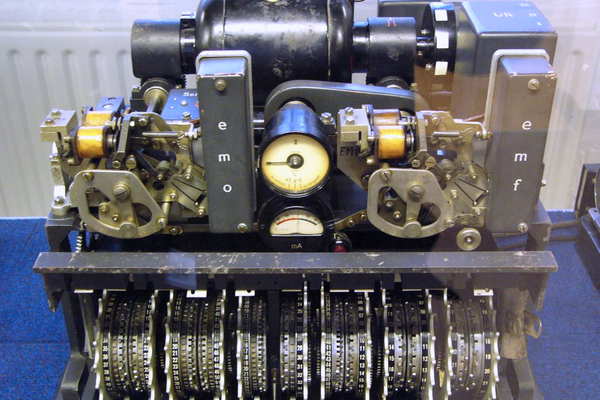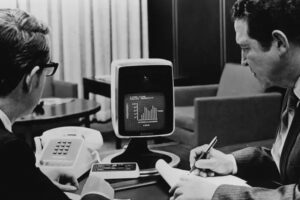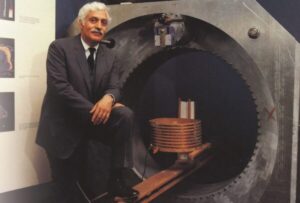Cryptography, which refers to the art of secret writing, has played a crucial role throughout history. It has been used to protect sensitive information and ensure secure communication between individuals and institutions. The Enigma machine, a fascinating cryptographic device, holds a significant place in the history of cryptography.
Table of Contents
Understanding Cryptography
Cryptography is the practice of securing communication from unauthorized access or third-party interception. It plays a crucial role in protecting sensitive information, including military strategies, classified documents, and personal data.
Ciphers and codes have been used throughout history for various purposes, such as to ensure the confidentiality of messages and to authenticate the identity of the sender. Ancient civilizations, like the Egyptians and ancient Greeks, used simple substitution ciphers to protect their messages. Over time, the complexity of these ciphers evolved, resulting in more sophisticated encryption techniques.
Encryption is especially vital in military operations, where the security of communication can be a matter of life and death. In times of war, cryptographic systems help ensure the secrecy of critical information, such as battle plans, troop movements, and intelligence reports. Without encryption, unauthorized access to these details could have devastating consequences.
Throughout history, different encryption methods and machines have been developed to enhance the security of messages. One of the most famous cryptographic machines is the Enigma. Its invention and widespread use in the early 20th century marked a significant milestone in the evolution of encryption technology.
Understanding cryptography and its various aspects allows us to appreciate the importance and impact of the Enigma machine. From the historical use of ciphers and codes to the critical role of encryption in military operations, each element contributes to the broader understanding of this fascinating field.
Origins of the Enigma Machine
The Enigma machine, a remarkable piece of cryptographic technology, played a pivotal role in shaping the field of cryptography during the 20th century. Its development and invention marked a turning point in the history of encryption. Initially, the Enigma machine was used in commercial sectors, such as banking and telecommunications, but its significance quickly extended to the military.
The development of the Enigma machine can be credited to the German engineer Arthur Scherbius, who introduced it in the early 20th century. This innovative machine employed a series of rotors, plugboard connections, and a reflector, all working together to scramble and unscramble messages. The complexity of the Enigma’s design made it highly secure and resistant to code-breaking attempts.
The early use of the Enigma machine by commercial and military sectors showcased its potential in revolutionizing cryptographic methods. Its adoption by the German military, particularly during World War II, was a significant turning point in the history of cryptography. The Enigma machine enabled secure communication for the Germans, giving them a substantial advantage over their adversaries.
The significance of the Enigma machine cannot be overstated. It not only allowed for the creation of complex and unbreakable codes but also forced cryptographers to find new ways to break them. The challenge of deciphering Enigma-encrypted messages pushed the boundaries of intelligence and paved the way for the formation of specialized code-breaking units, such as Britain’s Bletchley Park.
In summary, the origins of the Enigma machine mark a critical juncture in the history of cryptography. Its invention and early use in both commercial and military sectors demonstrated its potential in changing cryptographic methods. The subsequent impact of the Enigma machine, particularly during World War II, would lead to significant advancements in code-breaking techniques and ultimately shape the future of encryption.
Enigma in World War II
During World War II, the Enigma machine played a crucial role in military communications for the German military. Its adoption by the German military presented a significant challenge for the Allied forces. Enigma adoption by the German military was a game-changer in the realm of cryptography.
The Enigma machine, an electromechanical device, was used by the German military to encrypt their communications. It worked by substituting letters with other letters according to a complex system of rotating wheels, or rotors. Each day, the rotor settings and encryption keys would change, making it incredibly difficult to decipher the messages.
The Allied forces faced immense difficulties in deciphering Enigma codes. The complexity of the machine and the constant changes in its settings made it virtually impossible to crack the codes manually. However, the Allied forces were determined to overcome this challenge and gain access to valuable German intelligence.
To decipher Enigma codes, the Allies established the British code-breaking unit at Bletchley Park. This team of brilliant minds, including the renowned Alan Turing, worked tirelessly to find a solution. They developed innovative techniques and methods to break the Enigma codes.
Despite the difficulties they faced, the codebreakers at Bletchley Park made remarkable breakthroughs. They created the Bombe machine, an electromechanical device that significantly sped up the code-breaking process. By analyzing intercepted Enigma messages and exploiting weaknesses in the German operators’ methods, the Allies were able to decrypt crucial military intelligence. This breakthrough played a pivotal role in the outcome of the war.
The adoption of the Enigma machine by the German military during World War II was a turning point in the history of cryptography. It presented significant challenges for the Allied forces, who had to overcome the complexity and constantly changing settings of the machine. The codebreakers at Bletchley Park, with their relentless efforts and innovative techniques, ultimately succeeded in deciphering Enigma codes, providing invaluable intelligence to the Allied forces. The legacy of their accomplishments and the lessons learned from the Enigma machine continue to impact cryptography and cybersecurity to this day.,# The Battle of Bletchley Park
Establishment of the British code-breaking unit
During World War II, the British code-breaking unit at Bletchley Park played a crucial role in deciphering the Enigma codes used by the German military. This code-breaking unit was established as a top-secret operation, with the mission of decrypting and understanding the encrypted messages intercepted from the German forces.
Overview of the brilliant minds involved, including Alan Turing
Bletchley Park was home to some of the brightest minds of the time, with individuals like Alan Turing leading the charge in the battle against the Enigma machine. Turing, a brilliant mathematician and computer scientist, played a pivotal role in developing methods and techniques to decipher the Enigma codes. His work with the concept of the “Universal Turing Machine” laid the foundation for modern computer science.
Techniques and methods used for deciphering Enigma codes
At Bletchley Park, a multitude of techniques and methods were employed to break the Enigma codes. One of the most significant breakthroughs was the development of the “Bombe” machine, a device designed to automate the process of finding the daily settings of the Enigma machine. By analyzing intercepted messages, the code-breakers were able to exploit weaknesses in the Enigma’s encryption process and ultimately decrypt the coded messages.
The code-breakers at Bletchley Park also utilized statistical analysis, logical deductions, and complex algorithms to decipher the Enigma codes. They worked tirelessly to understand the patterns and intricacies of the encrypted messages, constantly adapting their techniques to overcome the ever-evolving Enigma encryption methods employed by the Germans.
Overall, the Battle of Bletchley Park was a race against time and a testament to human ingenuity. The brilliant minds involved in this code-breaking unit at Bletchley Park played a vital role in deciphering the Enigma codes, influencing the course of the war and shaping the future of cryptography.
Breakthroughs and the End of Enigma
The development and evolution of code-breaking techniques at Bletchley Park marked a significant turning point in the battle against the Enigma machine. The brilliant minds involved in deciphering Enigma codes, including Alan Turing, played a crucial role in the ultimate success of the Allied forces.
At Bletchley Park, a British code-breaking unit was established with the aim of decrypting the secret messages sent by the German military. This team of dedicated individuals worked tirelessly to unravel the complex encryption used by Enigma. Their intricate techniques and methods proved to be instrumental in breaking the seemingly impenetrable codes.
One of the most influential breakthroughs came in the form of the Bombe machine. This electro-mechanical device, developed by Turing and his team, was specifically designed to assist in deciphering Enigma messages. The Bombe machine revolutionized the code-breaking process, enabling faster and more efficient decryption.
The successful deciphering of Enigma codes had a profound impact on the outcome of the war. With access to vital German military intelligence, the Allied forces gained a crucial advantage in their strategic decision-making. This intelligence played a significant role in the success of various military operations, including the D-Day landings, and ultimately contributed to the Allied victory.
The legacy of Enigma and its impact on the field of cryptography cannot be overstated. The breakthroughs achieved at Bletchley Park laid the foundation for modern encryption technologies. The techniques and methods developed during this time have continued to influence and shape the field of cybersecurity.
In conclusion, the evolution of code-breaking techniques, the influence of the Bombe machine, and the impact of deciphering Enigma codes were key factors in the end of the Enigma machine’s reign of secrecy. The work done at Bletchley Park not only changed the course of the war but also paved the way for advancements in cryptography that we still benefit from today. The remarkable accomplishments of the code-breakers serve as a testament to the power of human ingenuity and the importance of relentless perseverance in the face of seemingly insurmountable challenges.
Legacy and Impact
The Enigma Cryptography Machine holds significant importance in the history of cryptography. Its invention and use during World War II shed light on the power of encryption and its impact on military operations and national security. The Enigma machine’s influence extends beyond its wartime applications, shaping modern encryption technologies and lessons learned in cybersecurity.
Importance of Enigma in the history of cryptography
The Enigma machine revolutionized cryptography, introducing a complex system that seemed unbreakable at the time. The Germans believed their encrypted messages were secure, unaware that code-breaking efforts at Bletchley Park were making remarkable progress. The deciphering of Enigma codes by Allied forces played a crucial role in the outcome of the war, allowing them to anticipate German movements and strategically plan their own operations.
Enigma’s influence on modern encryption technologies
The Enigma machine’s design and cryptographic principles have had a lasting impact on modern encryption technologies. Its use of mechanical rotors and electrical circuits paved the way for developments in electromechanical systems. Today, encryption algorithms and protocols draw inspiration from the Enigma machine, incorporating similar principles of secrecy and complexity to secure confidential information.
Lessons learned from Enigma and its impact on cybersecurity
The Enigma machine serves as a reminder of the importance of constantly innovating cryptographic methods. The code-breaking efforts at Bletchley Park showcased the need for continuous adaptability in the face of evolving encryption techniques. The lessons learned from cracking Enigma codes have directly influenced the field of cybersecurity, emphasizing the need for robust encryption algorithms, secure key management, and proactive system defenses.
In conclusion, the Enigma Cryptography Machine’s legacy is a testament to the power and impact of cryptography. Its role in history highlights the significance of encryption in both military operations and everyday cybersecurity. The Enigma machine’s influence on modern encryption technologies and the lessons learned from its deciphering efforts continue to shape the field, ensuring the ongoing development of secure and effective cryptographic systems.
Conclusion
The Enigma Cryptography Machine holds a significant place in the history of cryptography. Throughout this blog post, we have explored the origins, advancements, and impact of this remarkable device. From the introduction, we discovered that cryptography plays a vital role in safeguarding sensitive information and has been used throughout history for various purposes.
The Enigma machine, as we learned, was a groundbreaking invention that revolutionized cryptographic methods. Its development and early use by commercial and military sectors highlighted its importance and potential for secure communication. However, it was during World War II that the Enigma machine truly made its mark.
The adoption of Enigma by the German military posed a significant challenge for the Allied forces. The complexity of the machine and the constant changes in encryption settings made deciphering the messages incredibly difficult. The establishment of the British code-breaking unit at Bletchley Park, led by brilliant minds like Alan Turing, played a crucial role in unraveling the secrets of Enigma.
Breakthroughs in code-breaking techniques, particularly the influence of the Bombe machine, enabled the deciphering of Enigma codes and had a profound impact on the outcome of the war. The intelligence gathered from intercepted messages proved to be invaluable, as it provided the Allies with vital information and helped them gain a strategic advantage.
The legacy of the Enigma machine extends beyond its historical significance. It continues to influence modern encryption technologies and serves as a reminder of the importance of cybersecurity. The lessons learned from Enigma, such as the need for constant innovation and adaptability in cryptography, remain relevant in today’s digital age.
In conclusion, the Enigma Cryptography Machine remains a testament to the ingenuity and perseverance of those who worked to decipher its secrets. Its impact on the course of history cannot be overstated, and it serves as a reminder of the critical role that cryptography plays in ensuring the security and privacy of sensitive information. The Enigma machine continues to inspire advancements in cryptography and reminds us of the ongoing battle to protect information in an increasingly interconnected world.




